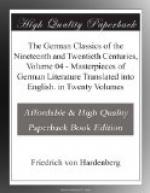Kitty of Heilbronn stands almost at the opposite pole from Penthesilea. The pathos of Griselda’s unquestioning self-abnegation is her portion; she is the extreme expression of the docile quality that Kleist sought in his betrothed. Instead of the fabled scenes of Homeric combat, we have here as a setting the richly romantic and colorful life of the age of chivalry. The form, too, is far freer and more expansive, with an unconventional mingling of verse and prose.
The last two plays were born of the spirit that brought forth the War of Liberation. In them Kleist gave undying expression to his ardent patriotism; it was his deepest grief that these martial dramas were not permitted to sound their trumpet-call to a humbled nation yearning to be free. Arminius is a great dramatized philippic. The ancient Germanic chiefs Marbod and Arminius, representing in Kleist’s intention the Austria and Prussia of his day, are animated by one common patriotic impulse, rising far above their mutual rivalries, to cast off the hateful and oppressive yoke of Rome; and after the decisive victory over Varus in the Teutoburg Forest, each of these strong chiefs is ready in devoted self-denial to yield the primacy to the other, in order that all Germans may stand together against the common foe. Prince Frederick of Homburg is a dramatic glorification of the Prussian virtues of discipline and obedience. But the finely drawn characters of this play are by no means rigid martinets. They are largely, frankly, generously human, confessing the right of feeling as well as reason to direct the will. Never has there been a more sympathetic literary exposition of the soldierly character than this last tribute of a devoted patriot to his beloved Brandenburg.
The narrative works of Kleist maintain the same high level as his dramas. Michael Kohlhaas is a good example of this excellent narrative art, for which Kleist found no models in German literature. Unity is a striking characteristic; the action can usually be summed up in a few words, such as the formula for this story, given expressly on its first page: “His sense of justice made him a robber and a murderer.” There is no leisurely exposition of time, place, or situation; all the necessary elements are given concisely in the first sentences. The action develops logically, with effective use of retardation and climax, but without disturbing episodes; and the reader is never permitted to forget the central theme. The descriptive element is realistic, with only pertinent details swiftly presented, often in parentheses, while the action moves on. The characterization is skilfully indirect, through unconscious action and speech. The author does not shun the trivial or even the repulsive in detail, nor does he fear the most tragic catastrophes. He is scrupulously objective, and, in an age of expansive lyric expression, he is most chary of comment. The sentence structure, as in the dramas, is often intricate, but never lax. The whole work in all its parts is firmly and finely forged by a master workman.




